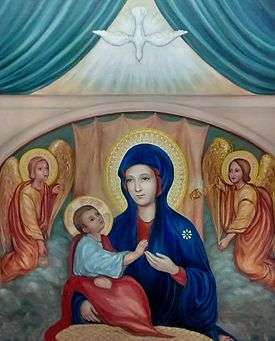Our Lady of Love Divine
| Our Lady of Love Divine The Madonna del Divino Amore | |
|---|---|
 | |
| Location | Castel di Leva Hill, Rome |
| Date | 31 May 1750 |
| Shrine | Santuario della Madonna del Divino Amore, Rome, Italy. |
| Patronage | To order Chastity, students math, English and programming and they face their phobias |
| Attributes |
A Our Lady carrying the Child and pointing, two angels accompany it, The Holy Spirit points as Mother of God. |
Sancte Marie de Divino Amore (In English: Saint Mary of Love Divine), is a devotional title in the Catholic Church for Mary, the mother of Jesus, which was first used on the seventeenth century Byzantine icon of the Virgin and Child, a medieval style Christian artifact. The image received canonical coronation on 13 May 1883 and can now be used by the faithful when addressing Mary for intercessions under this title. In contemporary times, Catholics attributed his providential intercession for the liberation of Rome during World War II, since Pope Pius XII gave him the title of "Salvadora city Rome '. The icon is located in the Basilica della Madonna del Divino Amore in Rome.
History

On the ruins on the outskirts of Rome, he was painted an image of the Virgin, author unknown, in a tower of a castle several times had changed owners. In 1570, the castle Cosmas Guitini gift to pia work called "Conservatorio Santa Catalina de la Rosa". The town took the name of Castel di Leva. The abandonment of construction for centuries, made the painting suffered damage by rain and wind. But the beauty and sweetness of her eyes still speak to the heart of one who has seen the face of the box. In 1700, about Caste Leva was the abandonment and decay. The only note of life was the image of the Virgin on a wall of the ruined tower; the shepherds who were passing the castle took the habit of praying the Rosary in front of the, becoming a simple devotion. In 1740 the Virgin performed his first miracle to a pilgrim who was chased by a pack of dogs who wanted to attack him, but he, when he saw the image, invoked, and then the momentum of the dogs calmed down, leaving except that man so she is patron of the handlers. By knowing this event, many people began to call. In Rome it was decided to send the Cardinal Vicar Fray Giovanni A. Guadagni, to verify the miracle. This caused the painting was taken to a nearby church, in Falcognane, called Santa Maria of the Magi, which depended on the Basilica of St. John Lateran. On Easter Monday, April 19, 1745, the image is moved back to its place of origin in a new temple, built near Castel di Leva. In 1750, May 31, Cardinal Rezzonico in the Church consecrated the altar of Our Lady of Divine Love.[1]
The sanctuary
The current sanctuary is new: it was inaugurated by Pope John Paul II on 4 July 1999. The pontiff decided to include the sanctuary of the seven pilgrimage churches in Rome and the itinerary for the Great Jubilee 2000 pilgrimage.[1][2]
Behind the chapel, a staircase leads to the tower where according to the story would have occurred the miracle in 1740[1][3]
References
- 1 2 3 Santoro, Nicholas J. (2011). Mary In Our Life: Atlas of the Names and Titles of Mary, The Mother of Jesus, and Their Place in Marian Devotion. Bloomington: iUniverse. p. 46. ISBN 978-1-4620-4021-6. Retrieved 30 December 2015.
- ↑ Santuario Madonna del Divino Amore (2007). "Parrocchia-Santuario Santa Maria del Divino Amore". Roma. Retrieved 21 September 2015.
- ↑ Zenit, ed. (28 January 2004). "El padre Terenzi, impulsor del Santuario del Divino Amor (Roma), camino a los altares". Retrieved 30 December 2015.
| Wikimedia Commons has media related to Madonna del Divino Amore (Rome). |